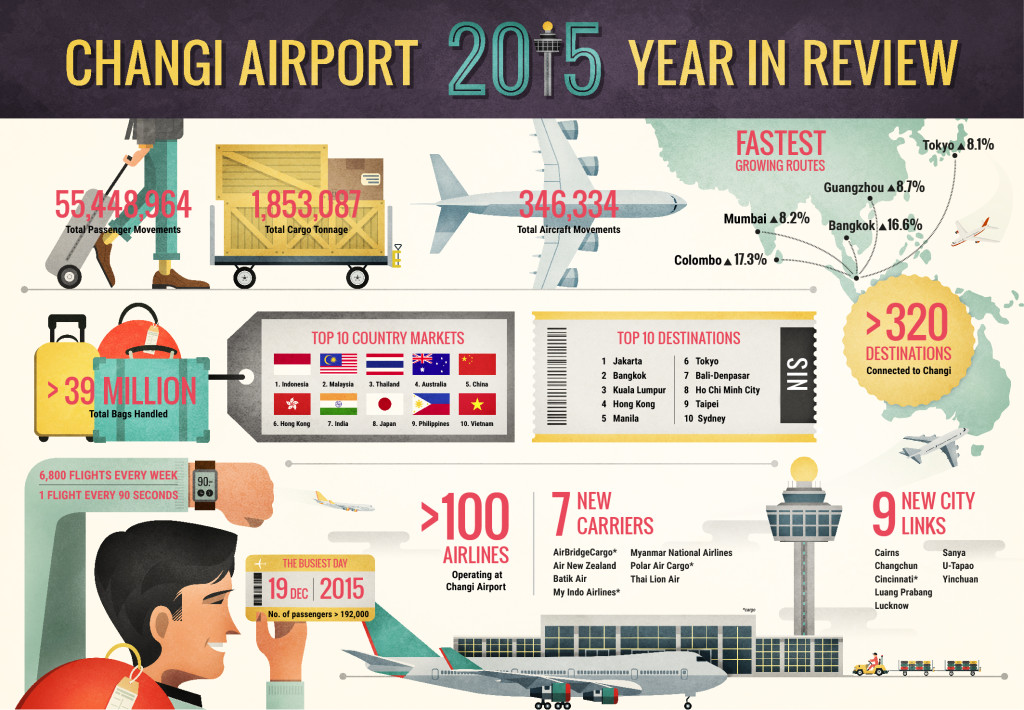
While passenger traffic and aircraft movements set new records at Singapore Changi Airport, ‘stability’ was the word of the year for airfreight movements which held steady at 1.85 million tonnes for 2015.
While Changi Airport’s total cargo throughput was little changed from a year earlier, there were pockets of growth in niche cargo segments and investment in new cargo infrastructure is expected to drive further growth in some of these niche sectors. For instance, there was strong double-digit growth in the pharmaceuticals cargo segment, which registered a 44 per cent growth year-on-year in 2015.
Supporting the growth of the express cargo segment, Changi Airport Group and DHL Express announced plans in March 2015 to build a 24-hour express facility at the Changi Airfreight Centre that will be completed later in 2016 to support the growth of trade within the region. The new facility would increase DHL’s throughput by three times and processing speed by six times, further anchoring Changi Airport’s position as a key cargo and logistics hub in Asia.
Similarly, SATS is also investing in an e-Commerce Hub at Changi Airport to tap the region’s booming e-commerce market, with Singapore Post (SingPost) as its anchor customer. Expected to be completed in December 2016, the new facility will improve efficiency and space utilisation, as well as enhance the consignment handling capabilities for both SATS and SingPost. SATS will be the first ground handler in the world to own such an airside facility.
During the year, three airlines (My Indo Airlines, Polar Air Cargo and AirBridgeCargo) enhanced Changi’s cargo network with new services, while seven passenger carriers commenced operations at Changi Airport. The return of Air New Zealand boosted capacity on the Singapore-Auckland route while the addition of Batik Air, Thai Lion Air and Myanmar National Airlines strengthened Changi’s connectivity within Southeast Asia.

Changi Airport added nine new destinations in 2015, highlighted by four new Chinese city links (Changchun, Quanzhou, Sanya and Yinchuan), strengthening the airport’s position as the most connected airport in Southeast Asia to China, with a total of 32 city links to the country. Besides the Chinese cities, Changi also saw new services to Cairns in Australia, Lucknow in India, Luang Prabang in Laos, Pattaya (U-Tapao) in Thailand and Cincinnati in the United States, a new freighter link.
Meanwhile, the airport handled a record 55.4 million passengers and 346,330 landings and take-offs during the year. This represented a year-on-year increase of 2.5 and 1.4 per cent respectively. In terms of Changi Airport’s busiest routes, Jakarta continued to top the list with 3.79 million passenger movements last year, followed by Bangkok, Kuala Lumpur, Hong Kong, Manila, Colombo, Guangzhou, Mumbai and Tokyo rounding up the top five.
Changi Airport Group CEO Lee Seow Hiang, said: “2015 was a year of two halves for Changi Airport. Following 2014, which saw a number of airline incidents in the region and depressed yields for many regional carriers, we had a relatively weak first six months with flat growth for the period. Nevertheless, we pressed on to actively woo new airlines and seek growth opportunities with existing ones, and our efforts have yielded some positive outcomes. We have seen both full-service and low-cost carriers add capacity in recent months and this has resulted in stronger passenger growth of about 5.0 per cent for the second half of the year.”









